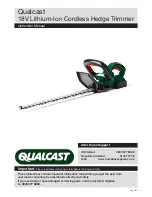
18
GB
1. Accident site
2. Accident type
3. Number of injured persons
4. Injury type(s)
Symbols
Caution!
Read the Operating Instructions!
Take the battery always out before any work
on the appliance.
Cable pulling / transport prohibited
In case of cable damage or nock, immedi-
ately pull out plug from socket
Keep distance of persons
Observe to keep out of dangerous zone
Protect against moisture
Never expose tool to rain.
Wear eye protection !
Wear ear protectors!
Wear protective gloves !
Wear safety cut through resistant shoes
with safety sole and steel toe !
Portez une tenue de protection avec
doublure contre perçage!
Any damaged or disposed electric or
electronic devices must be delivered to
appropriate collection centres.
Protect against humidity
This side up
General Power Tool Safety Warnings
Warning
Read all safety warnings and all instructions.
Failure
to follow the warnings and instructions may result in
electric shock, fire and/or serious injury.
Save all warnings and instructions for future
reference.
The term „power tool“ in the warnings refers to your
mains-operated (cordepower tool or battery-opera-
ted (cordless) power tool.
1) Work area safety
a)
Keep work area clean and well lit.
Cluttered or
dark areas invite accidents.
b)
Do not operate power tools in explosive atmo-
spheres, such as in the presence of flammable
liquids, gases or dust.
Power tools create sparks
which may ignite the dust or fumes.
c)
Keep children and bystanders away while opera-
ting a power tool.
Distractions can cause you to
lose control.
2) Electrical safety
a)
Power tool plugs must match the outlet. Never
modify the plug in any way. Do not use any
adapter plugs with earthed (groundepower
tools.
Unmodified plugs and matching outlets will
reduce risk of electric shock.
b)
Avoid body contact with earthed or grounded
surfaces, such as pipes, radiators, ranges and refri-
gerators.
There is an increased risk of electric shock if
your body is earthed or grounded.
c)
Do not expose power tools to rain or wet condi-
tions.
Water entering a power tool will increase
the risk of electric shock.
d)
Do not abuse the cord. Never use the cord for
carrying, pulling or unplugging the power tool.
Keep cord away from heat, oil, sharp edges or
moving parts.
Damaged or entangled cords
increase the risk of electric shock.
e)
When operating a power tool outdoors, use an
extension cord suitable for outdoor use.
Use of
a cord suitable for outdoor use reduces the risk of
electric shock.
f)
If operating a power tool in a damp location
is unavoidable, use a residual current device
(RCprotected supply.
Use of an RCD reduces the
risk of electric shock.
3) Personal safety
a)
Stay alert, watch what you are doing and use
common sense when operating a power tool. Do
not use a power tool while you are tired or under
the influence of drugs, alcohol or medication.
A moment of inattention while operating power
tools may result in serious personal injury.
b)
Use personal protective equipment. Always wear
eye protection.
Protective equipment such as dust
mask, non-skid safety shoes, hard hat, or hearing
protection used for appropriate conditions will
reduce personal injuries.
c)
Prevent unintentional starting. Ensure the
switch is in the off-position before connecting to
power source and/or battery pack, picking up or
carrying the tool.
Carrying power tools with your
finger on the switch or energising power tools that
ENGLISH
Summary of Contents for 93995
Page 68: ...64 BG d e f 3 a b c d e f g 4 a b c d e f g 5 a...
Page 83: ...79...
















































